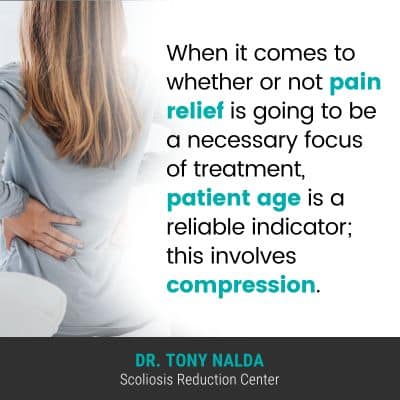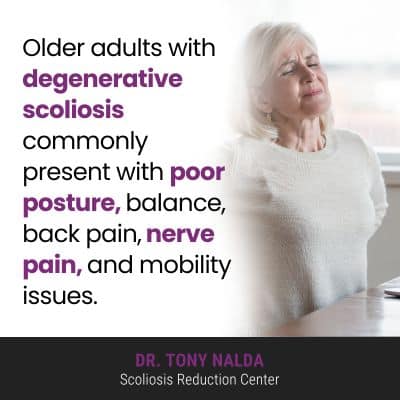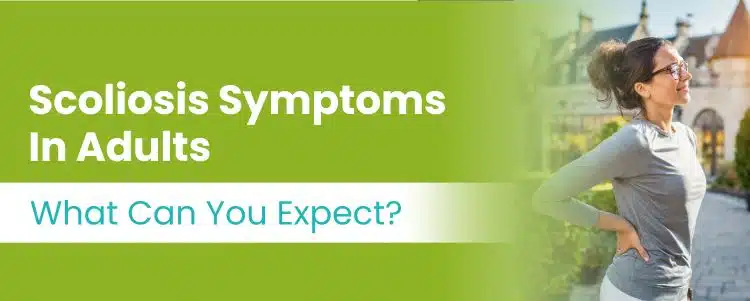Scoliosis is more commonly diagnosed in children, but the actual rate of scoliosis increases with age. The main symptom of scoliosis in young patients who have not yet reached skeletal maturity is postural deviation, and the main symptom of scoliosis in adults is pain caused by compressive forces.
Symptoms of scoliosis vary from patient to patient and are shaped by a number of important factors: patient age, condition severity, curvature location, and type. The main symptom of scoliosis that adults face more often than children is pain, and this is caused by compression.
Let’s start by exploring how the condition’s classification points shape symptoms of scoliosis in general, before focusing on the specific symptoms associated with adult scoliosis.
Classifying Scoliosis
As scoliosis is such a highly-variable condition, treatment plans need to be fully customized to address various patient/condition factors.
Part of diagnosing scoliosis involves further classifying conditions based on patient age, condition severity, curvature location, and condition type, so let’s address how each of these factors shape scoliosis symptoms in general, and with a focus on adult scoliosis.
If a diagnosis of scoliosis is reached, this means an unnatural sideways curvature of the spine has developed, so the spine curves to the side and also rotates, and it’s the twist in the spine that makes scoliosis a 3-dimensional condition.
The complex nature of scoliosis necessitates the complete customization of effective treatment plans, starting with patient age.
Patient Age and Adult Scoliosis Symptoms
Patient age is a key factor when it comes to two condition variables: progression and pain.
As a progressive condition, scoliosis is virtually guaranteed to worsen over time, and this means the size of the unnatural spinal curve is increasing, as are the condition’s uneven forces, and their effects.

Patient age can shape a patient’s rate of progression because it’s growth that triggers scoliosis to progress, so the younger a patient is at the time of their diagnosis, the more potential progression they can go through as the child grows.
The most common type of scoliosis is adolescent idiopathic scoliosis, diagnosed in patients between the ages of 10 and 18, and this age group is the most at risk for rapid-phase progression due to rapid and unpredictable growth spurts associated with puberty.
So patient age isn’t the only factor that affects progression, but it is a key variable.
Compression-Related Pain
When it comes to whether or not pain relief is going to be a necessary focus of treatment, patient age is a reliable indicator; this involves compression.
Compression means uneven forces and pressure, and scoliosis doesn’t become a compressive condition until skeletal maturity has been reached.
Once skeletal maturity has been reached, the spine and its surrounding muscles and nerves are exposed to compression, and this is the main cause of scoliosis-related pain; this can involve muscle pain, back pain, and/or pain that radiates into the extremities due to nerve compression.
While young patients don’t commonly experience a lot of back pain, this is the main scoliosis symptom that brings adults in to see me for a diagnosis and treatment.
Condition Severity and Adult Scoliosis Symptoms
When it comes to what experiencing daily life with scoliosis is like, condition severity is a key factor; the more severe a condition, the more overt its symptoms are likely to be, and the more likely related complications are.
Scoliosis severity ranges from mild scoliosis to moderate scoliosis and severe to very severe scoliosis, and severity is determined by a measurement known as Cobb angle.
A patient’s Cobb angle measurement is determined during X-ray by drawing lines from the tops and bottoms of the curve’s most-tilted vertebrae and the resulting angle is expressed in degrees.
The higher the Cobb angle, the more out of alignment the spine is, the more noticeable the condition’s symptoms are likely to be, and for adults, this includes postural changes and pain.
Postural changes can include uneven shoulders, uneven shoulder blades, the development of a rib cage arch, a prominent lean to one side, etc), and the more severe a condition, and the more rotation there is, the more painful it’s likely to be.
While mild, adult scoliosis symptoms can be subtle, but as progression occurs and conditions become more severe, symptoms tend to increase.
Curvature Location and Adult Scoliosis Symptoms
There are a number of spinal conditions that cause a loss of the spine’s healthy curves, and in most cases, the area of the body located the closest to an affected spinal section is where the majority of the condition’s direct effects are going to be felt.
The spine has three main sections, and scoliosis can develop in any one section, or in more than one as a combined scoliosis: cervical spine (neck), the thoracic spine (middle/upper back), and the lumbar spine (lower back).
Each spinal section has certain roles to play in maintaining spinal health and function, so each section affected by scoliosis can involve different symptoms felt in different areas of the body; for example, because the cervical spine has to support the weight of the neck, the head, and facilitates the neck’s range of motion, if scoliosis develops in the cervical spine, common symptoms in adults can include neck pain, shoulder pain, tension headaches, neck-muscle weakness, and a reduced range of motion in the neck.
When adult scoliosis develops in the lumbar spine, a common symptom is sciatic nerve pain; as the sciatic nerve starts in the lumbar spine, if the sciatic nerve root is compressed in the lower back, it can cause pain felt anywhere along the nerve’s extensive pathway, down the backside of the lower body.
So sciatic nerve pain felt down the back of the hip, buttocks, leg, and into the foot can be a symptom of lumbar scoliosis in adults.
As the thoracic spine is attached to the rib cage, thoracic scoliosis has the common effect of causing a rib cage arch and related chest and rib pain as the unnaturally-curved thoracic spine pulls on the rib cage, disrupting its natural position.
Now, under the umbrella of condition type, let’s explore the two main types of scoliosis to affect adults.
Condition Type and Adult Scoliosis Symptoms
There are different types of scoliosis that can develop, and type is determined by causation, and different symptoms of scoliosis are associated with different condition types.
The main type of scoliosis to affect all ages is idiopathic scoliosis, and this means cause unknown; this condition type accounts for approximately 80 percent of known diagnosed cases, and the remaining types of scoliosis are associated with known causes and are considered atypical: neuromuscular scoliosis, degenerative scoliosis, and congenital scoliosis.
Idiopathic scoliosis curves bend to the right, away from the heart, but in atypical types with known causes, curves can bend to the left, towards the heart; these tend to be more severe cases that cause more noticeable symptoms.
For example, neuromuscular scoliosis is caused by the presence of a larger neuromuscular condition such as cerebral palsy, muscular dystrophy, or spina bifida, and as the scoliosis develops as a secondary complication of a larger neuromuscular condition, symptoms tend to be overt:
- Pain
- Pelvic obliquity
- Difficulty standing upright
- Slouching posture
- A prominent lean to one side
- For patients who become wheelchair-bound, pressure sores are an additional effect
Neuromuscular conditions cause a disconnect between the brain and the muscles and/or connective tissues that support and stabilize the spine, disrupting its ability to maintain its natural curves and alignment.
But what are the two main types of scoliosis to affect adults: idiopathic scoliosis and degenerative scoliosis.
Idiopathic Scoliosis in Adults
The most common type of scoliosis to affect adults is idiopathic scoliosis, and these cases involve adolescents who had scoliosis but didn’t receive a diagnosis and/or treatment during adolescence, not becoming aware of their condition until it became compressive and painful.
It can be difficult to imagine that a person could live with scoliosis for so many years unaware, but remember, in children who have not yet reached skeletal maturity, the condition isn’t commonly painful, and when mild, it isn’t associated with functional deficits; as an adolescent grows and matures, they are moving closer towards compression, and once conditions become compressive, it’s pain that alerts them to the need for assessment and treatment.
Hence, when treating idiopathic scoliosis in adults, a focus of treatment is on reducing the size of the curve back to where it was prior to becoming symptomatic (painful).
Degenerative Scoliosis in Adults

The second most common type to affect adults is degenerative scoliosis, and this is most common in older adults over the age of 50, and is also more common in women due to changes in bone density and hormones related to menopause.
Degenerative scoliosis is caused by the cumulative effect of certain lifestyle factors and natural age-related spinal degeneration.
The more severe, the more unbalanced the spine and body are, and the more noticeable the symptoms are going to be; as degenerative scoliosis progresses, postural changes become more noticeable, the condition becomes more painful, and the spine becomes increasingly unstable.
In most cases of degenerative scoliosis, degenerative disc disease is a contributing factor, and this can involve bulging and or herniated discs, and symptoms can involve pain, pressure, and disruptions to movement, balance, and coordination.
Older adults with degenerative scoliosis commonly present with poor posture, balance, back pain, nerve pain, and mobility issues.
Conclusion
No two cases of scoliosis are the same, which is why the complex nature of the condition necessitates the customization of potentially-effective treatment plans.
When it comes to adult scoliosis, common symptoms include postural changes and pain, and treatment for adult scoliosis focuses on how to relieve pressure on the spine and its surroundings, reducing the curve size back to where it was prior to becoming painful and increasing spinal stability.
While adults tend to progress slower because the progressive trigger of growth is removed, progression does still occur, particularly when it comes to degenerative scoliosis and natural spinal degeneration; this is why the actual rate of scoliosis increases with age, although scoliosis is far more commonly diagnosed in children.
Here at the Scoliosis Reduction Center®, I’ve treated patients of all ages, and when it comes to minimizing the condition’s symptoms, the best approach is being proactive with treatment and customizing each and every treatment plan to address key patient and condition variables.




